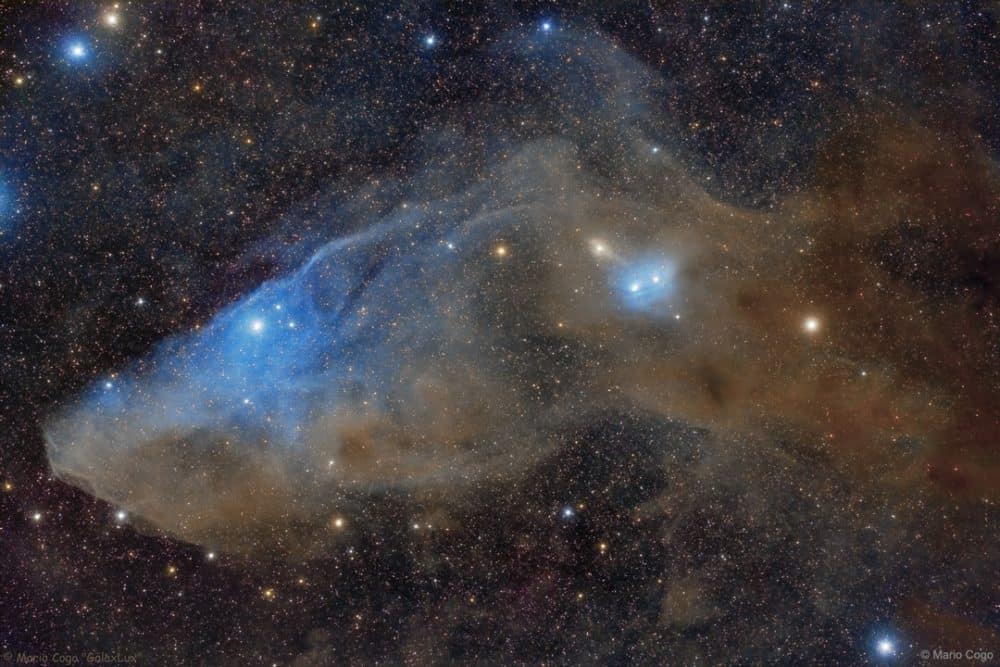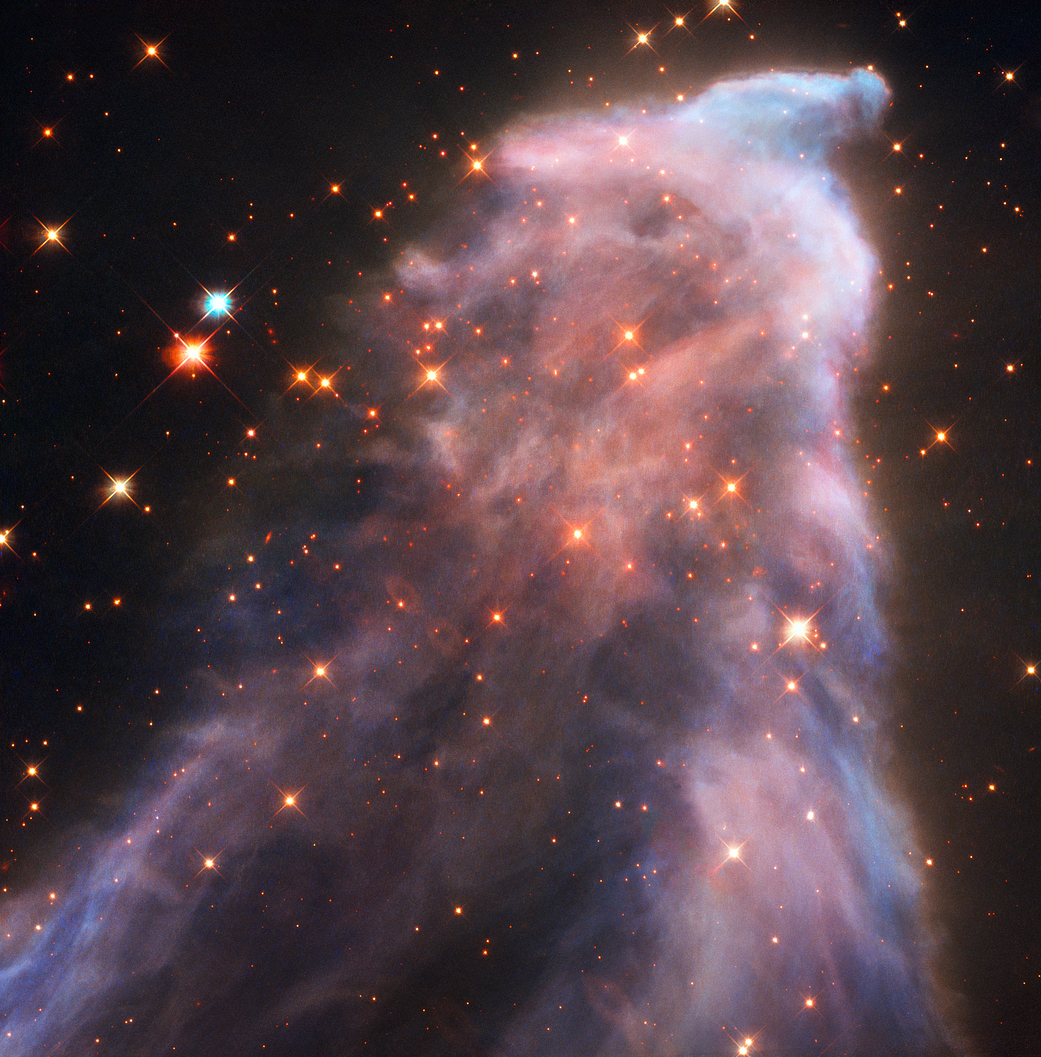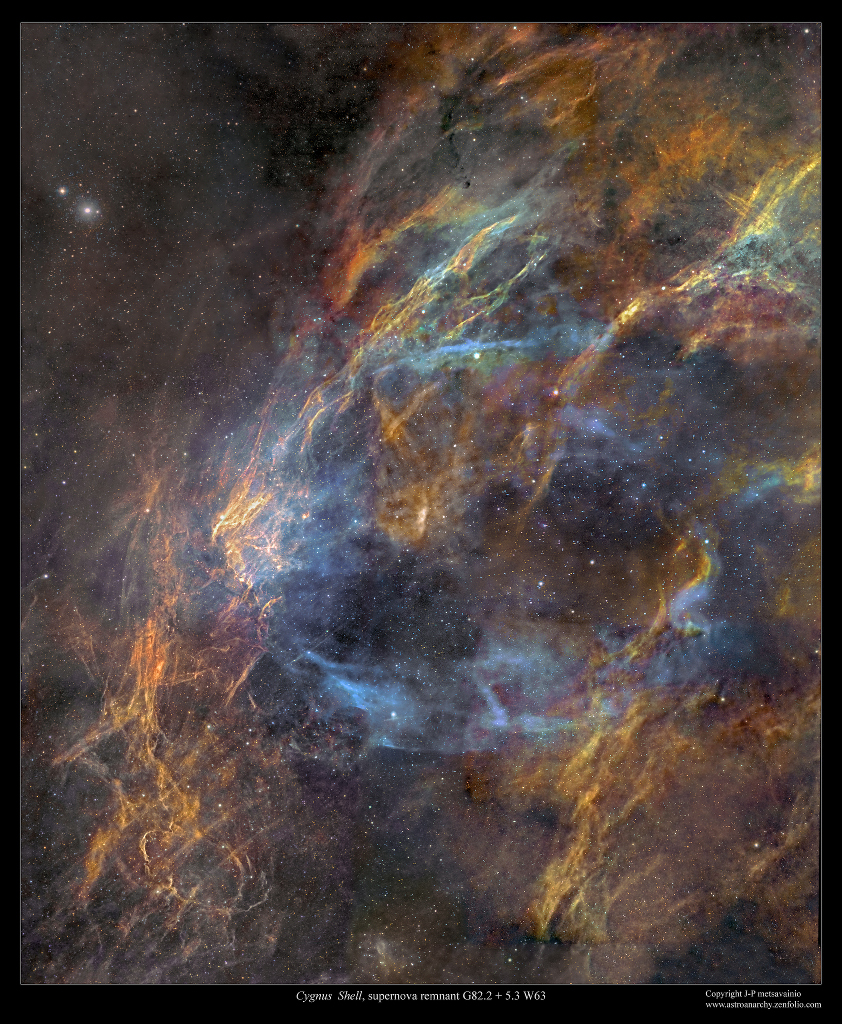Blog
IC 4592 (also known as the Blue Horsehead Nebula) is a reflection nebula in the Scorpius constellation that is lit by Nu Scorpii. 40 ly distance
What you are seeing is not the famous Horsehead nebula toward Orion but rather a fainter nebula that only takes on a familiar form with deeper imaging. The main part of the here imaged molecular cloud complex is a reflection nebula cataloged as IC 4592. Reflection nebulas are actually made up of very fine dust that normally appears dark but can look quite blue when reflecting the light of energetic nearby stars. In this case, the source of much of the reflected light is a star at the eye of the horse. That star is part of Nu Scorpii, one of the brighter star systems toward the constellation of the Scorpion (Scorpius). A second reflection nebula dubbed IC 4601 is visible surrounding two stars to the right of the image center.
more...Neil Cowley (born 5 November 1972) is a contemporary jazz pianist whose previous incarnations include Fragile State, the Green Nuns of the Revolution, and the Neil Cowley Trio, which appeared on Later… with Jools Holland in April 2008 and won the 2007 BBC Jazz Award for best album for Displaced.
Cowley was born in London. He began as a classical pianist and performed a Shostakovich piano concerto at the age of 10 at Queen Elizabeth Hall. In his late teens Cowley moved into being a keyboardist for soul and funk acts Mission Impossible, the Brand New Heavies, Gabrielle and Zero 7. He also appeared as a co-composer and session musician with the jazz-rock group Samuel Purdey. An early album was “Foxbury Rules”, released under the pseudonym Diamond Wookie.
more...Arthur Ira Garfunkel (born November 5, 1941) is an American singer, poet, math teacher and actor. He is best known for his partnership with Paul Simon in the folk rock duo Simon & Garfunkel.
Highlights of his solo music career include a top 10 hit, three top 20 hits, six top 40 hits, 14 Adult Contemporary top 30 singles, five Adult Contemporary number ones, two UK number ones and a People’s Choice Award. Through his solo and collaborative work, Garfunkel has earned eight Grammys, including a Lifetime Achievement Award. In 1990, he and Simon were inducted into the Rock and Roll Hall of Fame.
Garfunkel was born in Forest Hills, Queens, New York City, the son of Rose (née Pearlman) and Jacob “Jack” Garfunkel, a traveling salesman. Art is a middle child with two brothers, the older named Jules and the younger named Jerome. Jacob’s parents had originally emigrated to the United States at the turn of the century, and settled in Manhattan. Before his career in sales, Jacob worked as an actor in Dayton, Ohio. Garfunkel is Jewish; his paternal grandparents immigrated from Iași in Romania. His maternal cousin was Lou Pearlman.
https://www.youtube.com/watch?v=ucT-2YJslt8
more...https://www.youtube.com/watch?v=LBK7_DYxkpw
more...In the northern constellation of Coma Berenices (Berenice’s Hair) lies the impressive Coma Cluster — a structure of over a thousand galaxies bound together by gravity. Many of these galaxies are elliptical types, as is the brighter of the two galaxies dominating this image: NGC 4860 (centre). However, the outskirts of the cluster also host younger spiral galaxies that proudly display their swirling arms. Again, this image shows a wonderful example of such a galaxy in the shape of the beautiful NGC 4858, which can be seen to the left of its bright neighbour and which stands out on account of its unusual, tangled, fiery appearance. NGC 4858 is special. Rather than being a simple spiral, it is something called a “galaxy aggregate”, which is, just as the name suggests, a central galaxy surrounded by a handful of luminous knots of material that seem to stem from it, extending and tearing away and adding to or altering its overall structure. It is also experiencing an extremely high rate of star formation, possibly triggered by an earlier interaction with another galaxy. As we see it, NGC 4858 is forming stars so frantically that it will use up all of its gas long before it reaches the end of its life. The colour of its bright knots indicates that they are formed of hydrogen, which glows in various shades of bright red as it is energised by the many young, hot stars lurking within. This scene was captured by the NASA/ESA Hubble Space Telescope’s Wide Field Camera 3 (WFC3), a powerful camera designed to explore the evolution of stars and galaxies in the early Universe.
NGC 4860 is an elliptical galaxy in the constellation Coma Berenices. The galaxy was discovered on 21 April 1865 by Heinrich Louis d’Arrest.
With its distance from earth being approximately 110 million parsecs, NGC 4860 belongs to the Coma Cluster, which consists of over 1,000 identified galaxies
more...Jeffrey H. Lorber (born November 4, 1952) is an American keyboardist, composer, and record producer. After six previous nominations, Lorber won his first Grammy Award on Jan. 28, 2018 for Best Contemporary Instrumental Album for Prototype by his band The Jeff Lorber Fusion.
Many of his songs have appeared on The Weather Channel‘s Local on the 8s segments and on the channel’s compilation albums, The Weather Channel Presents: The Best of Smooth Jazz and The Weather Channel Presents: Smooth Jazz II. He was nominated for a Grammy Award for his album He Had a Hat (Blue Note, 2007)
Lorber was born to a Jewish family in Cheltenham, Pennsylvania, the same suburb as Michael and Randy Brecker, with whom he would later play.He started to play the piano when he was four years old. After playing in a number of R&B bands as a teen, he attended Berklee College of Music, where he developed his love for jazz.
more...Carlos Valdés (November 4, 1926 – December 4, 2007), better known as Patato, was a Cuban-born American conga player.[1] In 1954 he emigrated from La Habana to New York City where he continued his prolific career as a sideman for several jazz and Latin music ensembles, and occasionally as a bandleader. He invented and patented the tunable conga drum which revolutionized the use of the instrument in the US. Tito Puente once called him “the greatest conguero alive today”.
Like most Cuban musicians, Carlos Valdés had several nicknames throughout his artistic career. Early on he was known as “El Toro” (The Bull) as a young dancer and boxer. In school he was known as “Patato” (Potato) due to his short stature; more despectively he was known as “Remache” and “Tampón de bañera” around his neighbourhood. While playing alongside Armando Perazain Havana’s Zombie Club, he was known as “El Zombie”, “Zombito” or “Pequeño Zombie” (Little Zombie). Due to his dancing style he was known as “Pingüino” (Penguin). Nonetheless, “Patato” was the name that stuck and he carried this pseudonym to the US, where he was often miscredited as “Potato Valdez”.
more...https://www.youtube.com/watch?v=cpClblT0e-8
more...Powerful gushers of energy from seething stars can sculpt eerie-looking figures with long, flowing veils of gas and dust. One striking example is “the Ghost of Cassiopeia,” officially known as IC 63, located 550 light-years away in the constellation Cassiopeia the Queen.
The nebula’s ethereal glow might remind people of apparitions such as those reported by paranormal investigators. In reality, it’s simply hydrogen that is being bombarded with ultraviolet radiation from the nearby, blue-giant star Gamma Cassiopeiae (not seen here), causing it to glow in red light. The blue color is from light reflected off of the nebula’s dust.
The IC 63 nebula is not the only object under the influence of the blinding star, which unleashes as much energy as 34,000 suns. The Ghost Nebula is part of a much larger nebulous region surrounding Gamma Cassiopeiae that measures approximately two degrees on the sky — roughly four times as wide as the full Moon.
The constellation Cassiopeia is visible every clear night from mid-northern and higher latitudes. Its distinctive “W” asterism, which forms the queen’s throne, is best seen high in the sky on autumn and winter evenings. Gamma Cassiopeiae, the middle star in the W, is visible to the unaided eye, but a large telescope is needed to see IC 63.
more...Azar Lawrence (born November 3, 1952) is an American jazz saxophonist, known for his contributions as sideman to McCoy Tyner, Miles Davis, Freddie Hubbard, and Woody Shaw. Lawrence was the tenor saxophonist Tyner used following John Coltrane‘s death.
Lawrence released Summer Solstice on Prestige Records in 1975, produced by Orrin Keepnews. It featured Raul de Souza, Gerald Hayes, Amaury Tristão, Dom Salvador, Ron Carter, Guilherme Franco on the songs “Novo Ano” and “Highway” which were composed by Amaury Tristão, and Lawrence, Souza, Albert Dailey, Carter and Billy Hart on all other selections.
Bridge Into The New Age featured Jean Carn, Woody Shaw, Ray Straughter, Woody Murray, Clint Houston, Billy Hart, Guillerme Franco, Julian Priester, Hadley Caliman, Black Arthur, Joe Bonner, John Heard, Leon “Ndugu” Chancler, Mtume and Kenneth Nash.
more...Henry Grimes (born November 3, 1935) is a jazz double bassist, violinist, and poet.
After more than a decade of activity and performance, notably as a leading bassist in free jazz, Grimes completely disappeared from the music scene by 1970. Grimes was often presumed dead, but he was rediscovered in 2002 and returned to performing.
Henry Grimes was born in Philadelphia. He took up the violin at the age of 12, then began playing tuba, English horn, percussion, and finally the double bass in high school. He furthered his musical studies at Juilliard and established a reputation as a versatile bassist by the mid-1950s. He recorded or performed with saxophonists Gerry Mulligan, Sonny Rollins, pianist Thelonious Monk, singer Anita O’Day, clarinetist Benny Goodman and many others.
more...William Melvin Mitchell (November 3, 1926 – April 18, 2001) was an American jazz tenor saxophonist.
Mitchell was born in Kansas City, Missouri. He and his family moved to Detroit, where he received early music education at Cass Tech. He was known for his close association with trumpeter Thad Jones, who was also from Detroit, and worked in several big bands, including Woody Herman‘s when he replaced Gene Ammons. In 1949 Mitchell recorded with the Milt Buckner band, as well as making several recordings with Thad Jones.
From 1951 to 1954, Mitchell led the house band at the Blue Bird Inn in Detroit.The band operated in different configurations, including with drummer Oliver Jackson and his bassist brother Ali; as a quartet with Terry Pollard, Beans Richardson, and Elvin Jones; as a quintet including Thad Jones; and, for several months in 1953, with Miles Davis as a guest soloist.
From 1956 to 1957 he played with Dizzy Gillespie in his big band. From 1957 until 1961 and from 1966 to 1967 Mitchell played with Count Basie. In the early 1960s he co-led a group with Al Grey, The Al Grey Billy Mitchell Sextet, which won the Down Beat magazine new band award in 1962.
Mitchell performed and recorded with the Kenny Clarke/Francy Boland Big Band in Europe in the late 1960s and early 1970s. He was musical director for Stevie Wonder for a short time during this period. He died in Rockville Centre, New York, in 2001.
more...World Music on Flamenco Fridays is one day late.
Guajira (Flamenco) is a palo based on the Cuban Punto Guajira Cubana. It is in 12 beats and feels like it starts on 12. Guajíras is a prime example of so-called Cantes de Ida y Vuelta. The flamenco guajira is the adaptation to Melos flamenco of the Cuban point, the peasant point, a genre that brings together a series of songs called Guajiros that are grown in the rural areas of the island of Cuba. Guajíras is simply a song for voice and guitar with a series of similar letras.
The Guajíras is traditionally a woman’s dance. The dancer will often use a large Spanish fan. The fan is twirled and otherwise manipulated throughout the dance, adding an elegant and flirtatious air
more...Cygnus Shell Supernova Remnant W63
The ghost of a long-dead star, the W63 supernova remnant shines like a faint cosmic smoke-ring along the plane of the Milky Way galaxy toward the northern constellation Cygnus the swan. Its wraithlike appearance is traced against the region’s rich complex of interstellar clouds and dust by an eerie blue glow. Spanning over four full moons on the sky, the beautiful image is a telescopic mosaic in twelve panels that combines 100 hours of exposure time using narrow band filters. It shows characteristic light from ionized atoms of sulfur, hydrogen and oxygen in red, green, and blue hues. Likely over 5,000 light-years away, the visible part of the still expanding shell supernova remnant is around 150 light-years in diameter. So far no source has been identified as with the remains of W63’s original star. Light from the star’s supernova explosion would have reached Earth over 15,000 years ago.
more...More Posts
- Gil Coggins
- Wynona Carr
- World Music with Li Baomei & Jiang Zhongde
- Daily Roots with Joggo ft. Lutan Fyah
- The Cosmos with M78
- Donna Godchaux
- Dale Hawkins
- Malachi Favors
- Sonny Thompson
- John Lee Hooker
- Claude Debussy
- World Music with Kaushiki Chakraborty
- Daily Roots with Rod Anton
- The Cosmos with IC 1396
- Clydie Mae King
- Art Farmer
- Count Basie
- World Music Memorial for Larry Harlow
- Daily Roots with Justin Hines & the Dominos
- The Cosmos with NGC 520





